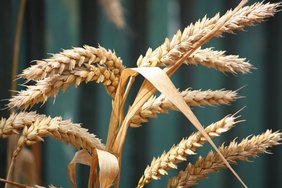
Prof. Nadina Müller
ZHAW Zurich University of Applied Sciences
Low water-content wheat bran will be fermented in an innovative biovalorisation process to partially degrade dietary fibre and lighten its colour. In a second step, high-quality pasta will be manufactured from a mixture of durum wheat semolina and the fermented bran (at a target ratio of 50:50) and compared with traditional pasta.
This study focused on upgrading wheat bran by fermentation. By utilising special lactic acid bacteria and yeasts, the properties of the bran were improved so it could be used in foods such as spaghetti. The resulting spaghetti, with 30% fermented bran content, was characterised by improved bite and flavour, without any significant change in colour.
The transformation to an efficient and sustainable Swiss food system requires the reduction of food losses along the entire value chain. Around 48% of the calories produced are lost in the food value chain. In Switzerland, 2.3 million tonnes of dry matter food are produced annually, of which 0.51 million tonnes are by-products. Many of these side streams are characterised by a high dietary fibre and protein content and are therefore used as animal feed instead of being upgraded for human consumption. The cost-benefit analysis of the protein and food fibre-rich side streams in Switzerland has shown that malt spent grains, fruit spent grains and oilseed press cakes from the sunflower and rapeseed oil industry are suitable for human consumption due to the quantity and nutrient composition. All side streams are regularly produced in large quantities and are mainly used as animal feed until now. Malt spent grains and fruit pomace have a short shelf life and fermentation sets in just a few hours after accumulation. Oilseed press cakes have a longer shelf life as they contain fewer short-chain carbohydrates and are therefore less susceptible to microbial spoilage. Malt spent grains contain a high proportion of resistant starches, cellulose hemicellulose, lignin and proteins, while fruit pomace has a high proportion of pectins, cellulose, hemicellulose and a low protein content. Oilseed press cakes are characterised by their high protein content. The high temperature, high pressure, twin screw wet extrusion (HTHDDSNE) of malt spent grains has shown that pre-grinding and mechanical dewatering leads to a dimensionally stable extrudate. The malt spent grain extrudate has low elasticity and is crumbly, but is characterised by a balanced dietary fibre composition. By mixing malt spent grain with oilseed press cake, an elastic, dimensionally stable extrudate was produced that is characterised by a high protein and dietary fibre content. The nutritional study investigated the effect of regular malt spent grain intake on digestive activity. The study was carried out with malt spent grains extrudate, as this contains an optimal dietary fibre composition. The celluloses, hemicelluloses, lignins, resistant starches and beta-glucose present have a positive effect on irritable bowel syndrome and chronic constipation and reduce the risk of cardiovascular disease. Six voluntary male participants aged 30 and 31 were recruited for the study. The participants recorded their dietary fibre intake from which the daily protein, carbohydrate, fat and dietary fibre intake was calculated. In addition, the duration, frequency and consistency of bowel movements were recorded. This was carried out for four weeks. An intervention was then carried out for seven days: Three participants each were asked to consume three portions (10g each) of malt cereal extrudate (supplementation of 15g dietary fibre) or rusk (placebo) daily before the three main meals. The supplementation group showed an increased frequency of bowel movements and a shortened duration of bowel movements during supplementation. The results of this study show that solid extrudates can be produced from nutrient fibre-rich Swiss side streams. When consumed regularly, these lead to a modulation of digestive activity.
This text was translated with DeepL
In the Food 4.0 programme, the Swiss Academies of Arts and Sciences, under the leadership of the Swiss Academy of Engineering Sciences SATW, support innovative project ideas that are at the very beginning of development. In particular, the programme supports projects that demonstrate new perspectives for the successful development of the Swiss food system. The selected projects make an important contribution to solving the greatest challenges and address the topics of food waste, sustainability and health.